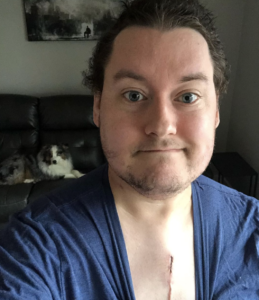Healthcare from the Inside: My Patient Experience
One of the big reasons I’m so passionate about patient experience is that I have been a patient myself. In January 2021, I spent two weeks in the hospital before undergoing a CABG (Coronary Artery Bypass Grafting) procedure.
The first couple of hours I spent at Advocate were probably the most eventful parts of my stay, excluding the actual CABG surgery. This happens when you collapse in the ER – they tend to pay attention and take that kind of thing seriously, especially when you’re crazy tachy.
However, the rest of the time I spent in the hospital for my heart was spent waiting. Waiting for a test, medication, diagnosis, or just to be seen by a provider. Waiting, waiting, and more waiting. It wasn’t the kind of waiting where the line is actually fun (looking at you Disney) – it was the stressful, scary, “am I going to die?” kind of waiting. This isn’t the fault of the hospital system, but it does make a patient feel like they’re largely at the mercy of a system that is opaque and confusing for those not used to dealing with it on an everyday basis.
I also had the context of working for a healthcare clinic and understanding (to an extent) how medicine is practiced. Seeing healthcare from the inside but not as a provider gave me a unique point of view. I didn’t know what was going on – I was just scared and along for the ride. I still was curious though – and instead of thinking about myself too much, I thought through the patient experience and what could be done to improve it.
In today’s world, we are used to having too much information and needing to filter it out to function effectively. This hospital stay was the exact opposite; not much information and a LOT of waiting/ruminating. So, what could have been improved?
1. Better Integration of a Patient Portal into Care: Over communication will always trump a lack of it. One of the best ways for patients to stay updated on test results, diagnoses, appointments & wait times is to use the patient portal (this is even better if it’s done in real-time). However, during the hospital stay this wasn’t prioritized in the same way as an outpatient experience. Most of the discussions/updates were centered on in-person interactions that happened during daily rounds. I didn’t necessarily need a Domino’s Pizza tracker – but I definitely needed a better system to give me real time updates. A better patient portal could have done this.
2. Patient Education and Empowerment: Using interactive systems (like tablets) to educate patients about their condition and treatment plans could have added far more clarity to what was going on with my stay. Unfortunately, a lot of the educational materials about procedures, medications, and recovery processes came in the form of paper packets. The experience felt more one size fits all versus a personalized, custom approach.
3. Post Discharge Support: Having your chest cracked open can do a number on anyone (particularly from an emotional perspective). Specialized mental health counselors/professionals ready to address the non-physical concerns can make a huge difference on the overall emotional health of a patient. This was key in my own recovery – but it was something that I had to seek out on my own. You can’t just treat the body, you need to treat the head as well.
AI integration wasn’t even a consideration in 2021 – but it could provide massive improvements for patients in the next 5-10 years. We’re just beginning to scratch the surface of enhancing the patient experience. What are some other ways you can think of that could have made a difference?
